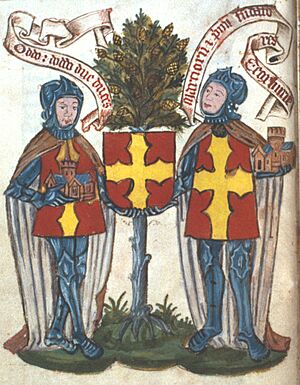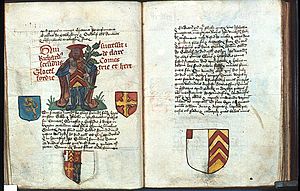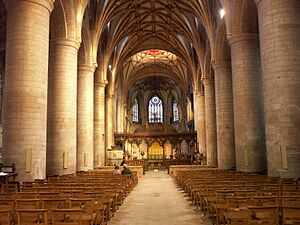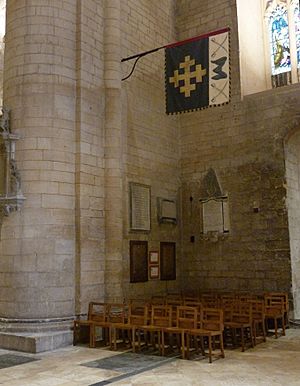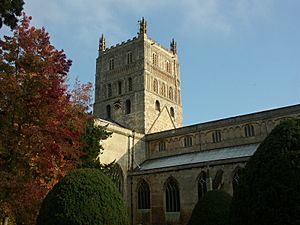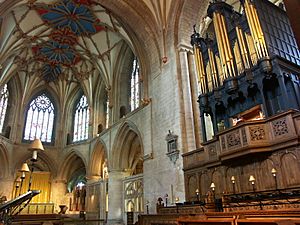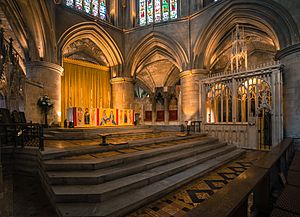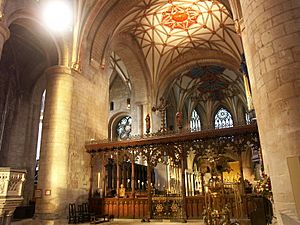Tewkesbury Abbey facts for kids
Quick facts for kids Parish Church of St Mary the Virgin |
|
|---|---|

Tewkesbury Abbey
|
|
| 51°59′25″N 2°9′38″W / 51.99028°N 2.16056°W | |
| Country | England, United Kingdom |
| Denomination | Church of England |
| Churchmanship | High church / Modern Catholic |
| Website | www.tewkesburyabbey.org.uk |
| History | |
| Dedication | St Mary the Virgin |
| Administration | |
| Parish | Tewkesbury |
| Diocese | Gloucester |
| Province | Canterbury |
The Abbey Church of St Mary the Virgin, Tewkesbury, often called Tewkesbury Abbey, is a famous church in Gloucestershire, England. It used to be a Benedictine monastery (a place where monks live and worship). Now, it is a parish church for the local town. Many people think it's one of the best examples of Norman architecture in Britain. It also has what might be the largest Romanesque tower in Europe.
People have worshipped in Tewkesbury since the 7th century. A smaller religious house, called a priory, was set up there in the 10th century. The building you see today was started in the early 12th century. During the Wars of the Roses, people tried to find safety inside the abbey, but it didn't work. After King Henry VIII closed down monasteries in England (called the Dissolution of the Monasteries), Tewkesbury Abbey became the main church for the town. In the late 1800s, George Gilbert Scott led a big project to fix and restore the building. Inside the abbey and its churchyard, you can find tombs and memorials for many important people from the area.
Today, the church holds different types of services, including Parish Eucharist (a communion service), choral Mass (a sung service), and Evensong. These services feature the church's three organs and its choirs. The abbey also has a set of twelve bells that are used for change ringing, a special way of ringing bells in patterns.
Contents
History of Tewkesbury Abbey
Records from the Chronicle of Tewkesbury say that the first Christian worship in this area was started by Theoc. He was a missionary from Northumbria who built a small hut in the mid-7th century. This hut was near where the Severn and Avon rivers meet. Later, in 715, a monastery was built there, but no parts of it remain today.
In the 10th century, the religious group in Tewkesbury became a priory. This meant it was a smaller part of Cranborne Priory in Dorset. In 1087, William the Conqueror gave the land of Tewkesbury to his cousin, Robert Fitzhamon. Robert, along with Giraldus, the Abbot of Cranborne, started the current abbey in 1092. The building of the Abbey church began in 1102. Workers used Caen stone that was brought all the way from Normandy and floated up the River Severn.
Robert Fitzhamon was hurt in France in 1105 and died two years later. But his son-in-law, Robert FitzRoy, who was the son of King Henry I, continued to pay for the building work. Later, Lady Eleanor le Despenser was a very important supporter of the Abbey. During the Middle Ages, Tewkesbury became one of the richest abbeys in England.
After the Battle of Tewkesbury on May 4, 1471, during the Wars of the Roses, some defeated soldiers tried to find safety in the abbey. However, the winning army, led by King Edward IV, forced their way in. There was fighting inside the abbey, which meant the building had to be closed for a month to be cleaned and blessed again.
During the Dissolution of the Monasteries, the last abbot, John Wakeman, gave the abbey to King Henry VIII's officials on January 9, 1539. Because he cooperated, he was given money and later became the first Bishop of Gloucester. Meanwhile, the people of Tewkesbury saved the abbey from being destroyed. They argued that it was their parish church and they had the right to keep it. They bought it from the King for the price of its bells and lead roof, which would have been melted down. This saved the building from becoming a ruin. The price was £453.
The bells were so important that they had their own separate bell tower. This was unusual for churches in England. After the Dissolution, this bell tower was used as the town's prison until it was taken down in the late 1700s.
The main stone tower originally had a wooden spire on top, but it fell down in 1559 and was never rebuilt. A big restoration project happened in the late 1800s, led by Sir George Gilbert Scott. It was finished on September 23, 1879. His son, John Oldrid Scott, continued the work until 1910, adding things like the rood screen in 1892.
The River Severn has flooded the abbey twice, once in 1760 and again on July 23, 2007.
Building Milestones
- 23 October 1121 – The choir (the part of the church where the choir sings) was officially blessed.
- 1150 – The tower and the nave (the main part of the church) were finished.
- 1178 – A large fire meant some parts had to be rebuilt.
- Around 1235 – The Chapel of St Nicholas was built.
- Around 1300 – The Chapel of St. James was built.
- 1321–1335 – The choir was rebuilt with special chapels around it.
- 1349–59 – The tower and nave ceilings were rebuilt. The wooden roof of the nave was replaced with stone vaults.
- 1400–1410 – The cloisters (covered walkways) were rebuilt.
- 1438 – The Chapel of Isabel (Countess of Warwick) was built.
- 1471 – After the Battle of Tewkesbury, there was fighting inside the church. It was closed for cleaning.
The Abbey Building
The church itself is one of the best Norman buildings in England. Its huge central tower is thought to be "probably the largest and finest Romanesque example in England." Many of England's cathedrals are smaller than Tewkesbury Abbey. Only Westminster Abbey has more medieval church monuments.
Important Tombs and Memorials
Many important people are buried or remembered in Tewkesbury Abbey:
- 1107 – The abbey's founder, Robert Fitzhamon, was buried here. His son-in-law, Robert FitzRoy, continued building the abbey.
- 1375 – Edward Despenser, a lord of Tewkesbury, has a monument showing him kneeling.
- 1395 – Robert Fitzhamon's remains were moved to a new chapel built as his tomb.
- 1471 – A brass plate on the floor marks the grave of Edward of Westminster, Prince of Wales. He was the son of King Henry VI and was killed in the Battle of Tewkesbury at only 17 years old. He is the only Prince of Wales to die in battle.
- 1478 – The bones of George, Duke of Clarence (brother of Edward IV and Richard III), and his wife Isabel, are kept behind glass in a hidden vault.
- 1539 – Abbot Wakeman had a special tomb built for himself, but he was not actually buried there.
- Many members of the Despenser, de Clare, and Beauchamp families are also buried here. They gave a lot of money to the abbey.
The Three Organs
Tewkesbury Abbey has three organs:
- The Milton Organ: This 17th-century pipe organ was first made for Magdalen College, Oxford. After the English Civil War, it moved to Hampton Court Palace, where the poet Milton might have played it. It came to Tewkesbury in 1737 and has been rebuilt several times.
- The Grove Organ: Located in the North Transept, this large organ was built in 1885.
- The Elliott Organ: This smaller chamber organ was built in 1812 and can be moved around the abbey.
Organists of the Abbey
Many talented musicians have served as organists at Tewkesbury Abbey over the centuries. Here are some of them:
- James Cleavely, 1737–1767
- Nathaniel Chandler, 1798–1847
- Edward Gillman, 1861–1867
- John Thorniloe Horniblow, 1867–1878
- Henry Rogers, 1878–1880
- Daniel Hemmingway, 1881–1891
- Samuel Bath, 1891–1900
- Alfred W. V. Vine, 1900–1910
- Capt. Percy Baker, 1910–1943
- Michael Stockwin Howard, 1943–1944
- Huskisson Stubington, 1944–1966
- Michael Peterson, 1966–1985
- John Belcher, 1985–1996
- Carleton Etherington, 1996–present
The Abbey Bells
The bells at Tewkesbury Abbey were updated in 1962. There are now twelve bells, used for change ringing. They were made by John Taylor & Co in 1962. The words from some of the old bells are copied onto the new ones. The bells have modern parts and run smoothly. They are in the north-east part of the tower. In 1991, another bell was added, making a total of 13 bells that can be rung.
Some older bells, called the Old Clock Bells, are still in the tower. In St Dunstan's Chapel, there is also a small bell that is no longer used.
The Abbey bells are rung every Sunday morning from 10:15 am to 11:00 am, except on the first Sunday of the month. They are also rung for Evensong on Sunday evenings from 4:00 pm to 5:00 pm, except on the third and most fifth Sundays. People practice ringing the bells every Thursday evening.
Churchyard and Abbey Grounds
The churchyard has graves for two Royal Air Force members who died in World War II.
The town of Tewkesbury grew up north of the abbey. You can still see parts of the old abbey grounds in the street layout and some buildings. These include the Abbot's gatehouse, the Almonry barn, the Abbey Mill, Abbey House, the current vicarage, and some old wooden houses on Church Street. The abbey now stands surrounded by open lawns, like a cathedral. This area is protected from new buildings by the Abbey Lawn Trust, which was started with money from a person in the United States in 1962.
Abbots of Tewkesbury Abbey
An abbot was the head of the monastery. Here are some of the abbots who led Tewkesbury Abbey:
- Gerald of Avranches (1102–1109)
- Robert (1109–1123)
- Benedict (1124–1137)
- Roger (1137–1161)
- Fromund (1162–1178)
- Alan of Tewkesbury (1186–1202)
- Walter (1202–1213)
- Hugh or Henry (1212–1215)
- Peter of Worcester (1216–1232)
- Robert (1232–1254)
- Thomas de Stoke (1255–1276)
- Richard of Norton (1276–1282)
- Thomas of Kempsey (1282–1328)
- John de Cotes (1330–1347)
- Thomas de Leghe (1347–1361)
- Thomas de Chesterton (1361–1389)
- Thomas Parker (1389–1420)
- William de Bristol (1425–1442)
- John de Abingdon (1444–1452)
- John Galeys (1452–1468)
- John Streynesham (1468–1480)
- Richard Cheltenham (1480–1509)
- Henry Beely (1509–1534)
- John Wyche alias John Wakeman (1534–1540) – He was the last abbot before the monastery was closed.
Abbey Choirs
The Abbey has two main choirs. The Abbey Choir sings at Sunday services, with children (boys and girls) and adults in the morning. The adults also sing in the evening. The Schola Cantorum is a professional choir of men and boys. They sing at weekday Evensongs and sometimes at masses and concerts. This choir is based at Dean Close Preparatory School.
Worship Services
Worship at Tewkesbury Abbey has often been very traditional. However, more recently, the abbey has also started offering less formal services. This is why there are two different services on Sunday mornings. The first service (at 9:15 am) is a Parish Eucharist, which uses modern language and has a relaxed feel. A breakfast is often served after this service. The main Sung Eucharist at 11 am is more formal and includes a choral Mass. This service uses traditional language, and most parts are sung. Choral Evensong is sung on Sunday evenings, and also on Monday, Tuesday, Thursday, and Friday during the week. A spoken Eucharist service also happens every day of the week.
Every summer since 1969 (except for 2007 when there were floods), the Abbey has hosted Musica Deo Sacra. This is a festival that combines music and church services. Taking photos inside the Abbey is usually not allowed.
See also
 In Spanish: Abadía de Tewkesbury para niños
In Spanish: Abadía de Tewkesbury para niños


